















Nash Airflyte |
|---|
|
| Topic Navigation |
|---|
|
Wikipedia: Nash Motors
Page Sections History Images |
History
The following section is an excerpt from Wikipedia's Nash Motors page on 10 July 2016, text available via the Creative Commons Attribution-ShareAlike 3.0 Unported License.
Introduction of the Nash Airflyte
The aerodynamic 1949 Nash "Airflyte" was the first car of an advanced design introduced by the company after the war. Its aerodynamic body shape was developed in a wind tunnel. Nils Wahlberg's theories on reducing an automobile body's drag coefficient resulted in a smooth shape and enclosed front fenders. The "cutting-edge aerodynamics" was the most "alarming" all-new postwar design in the industry since the Chrysler Airflow. A one-piece curved safety glass windshield was used on both models. Wide and low, the automobile featured more interior room than its 1948 predecessor although its height was 6 inches less. Due to its enclosed front fenders Nash automobiles had a larger turning radius than most other cars. The 600 models used a 112-inch (2,800 mm) wheelbase while the Ambassador models stretched to 121 inches (3,073 mm). Both shared the same bodies. Coil springs were used on all four wheels. Three trim lines were offered in both models; Super, Super Special, and the top line Custom. Power was provided by an 82 Horsepower 176 cubic inch flathead inline 6 cylinder in the 600 and an 112 HP OHV 234 cubic inch inline 6 in the Ambassador.
The few changes for the 1950 Airflytes were a wider rear window, concealed fuel filler cap, some dashboard features and addition on Ambassadors of a GM Hydramatic automatic transmission option. The 600 models were renamed the "Statesman". A new first for an American car were seat belts, also new was a five-position Airliner reclining front passenger seat back, both optional in both models. The stroke on the Statesman engine was increased 1/4 inch giving 186 cubic inches and 85 HP and the Ambassador received a new cylinder head that increased HP to 115.
Changes for the 1951 model Airflytes were to the rear fenders, elongated to incorporate vertical taillights, a new conventional dashboard replacing the Uniscope mounted on the steering column, a new vertical bar grille with horizontal parking lights and addition of GM Hydramatic as a Statesman option also. The three best sales years for Nash up to that time were 1949, 1950 and 1951.
Nash-Kelvinator's President George Mason felt Nash had the best chance of reaching a larger market in building small cars. He directed Nash towards the development of the first compact of the post war era, the 1950 Nash Rambler, which was marketed as an up-market, feature-laden convertible. Mason also arranged for the introduction of the Austin-built small Metropolitan from Britain, which was introduced as a 1954 model.
The full-size Nash Airflytes were completely re-designed for 1952, and were promoted as the Golden Airflytes, in honor of Nash Motors' 50th anniversary as an automobile builder (the company now counting the years of the Thomas B. Jeffery Company as part of their own heritage.) "Great Cars Since 1902" became one of the company's advertising slogans. Nash was one of the few American car manufacturers to introduce an all-new 1952 model other than Ford Motor Company. The new Golden Airflytes presented a more modern, squared-off look than did the 1949–1951 models, which were often compared to upside-down bathtubs. Pininfarina of Italy was contracted by Nash to design a body for the new Golden Airflyte; however management was unhappy with the design and the result was a combination of an in-house design and Pininfarina's model.
Using its Kelvinator refrigeration experience, the automobile industry's first single-unit heating and air conditioning system was introduced by Nash in 1954. This was a compact, affordable system for the mass market with controls on the dash and an electric clutch. Entirely incorporated within the engine bay, the combined heating and cooling system had cold air for passengers enter through dash-mounted vents. Competing systems used a separate heating system and an engine-mounted compressor with an Evaporator in the car's trunk to deliver cold air through the rear package shelf and overhead vents. The alternative layout pioneered by Nash "became established practice and continues to form the basis of the modern and more sophisticated automatic climate control systems."
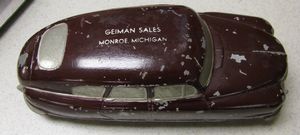 |
Subject: 1949 Nash Airflyte Banthrico Promotional Scale Model from Geiman Sales of Monroe, Michigan
Photographer: Bill Crittenden Event: August 2011 Meeting of C.A.R.S. in Miniature View photo of 1949 Nash Airflyte Banthrico Promo - 1,025KB |
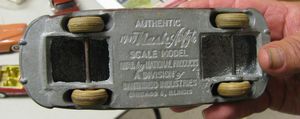 |
Subject: 1949 Nash Airflyte Banthrico Promotional Scale Model from Geiman Sales of Monroe, Michigan
Photographer: Bill Crittenden Event: August 2011 Meeting of C.A.R.S. in Miniature View photo of 1949 Nash Airflyte Banthrico Promo - 1,046KB |
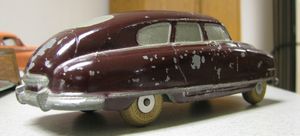 |
Subject: 1949 Nash Airflyte Banthrico Promotional Scale Model from Geiman Sales of Monroe, Michigan
Photographer: Bill Crittenden Event: August 2011 Meeting of C.A.R.S. in Miniature View photo of 1949 Nash Airflyte Banthrico Promo - 1,050KB |
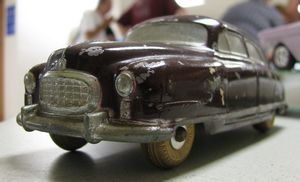 |
Subject: 1949 Nash Airflyte Banthrico Promotional Scale Model from Geiman Sales of Monroe, Michigan
Photographer: Bill Crittenden Event: August 2011 Meeting of C.A.R.S. in Miniature View photo of 1949 Nash Airflyte Banthrico Promo - 1,061KB |
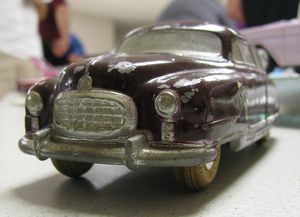 |
Subject: 1949 Nash Airflyte Banthrico Promotional Scale Model from Geiman Sales of Monroe, Michigan
Photographer: Bill Crittenden Event: August 2011 Meeting of C.A.R.S. in Miniature View photo of 1949 Nash Airflyte Banthrico Promo - 1,011KB |
 |
Subject: 1952 Nash Golden Airflyte Advertisement from Larry's Nash Motor Sales (Dunn, North Carolina)
Source: The Daily Record Date: 20 May 1952 View image of 1952 Nash Golden Airflyte Advertisement - 906KB |
